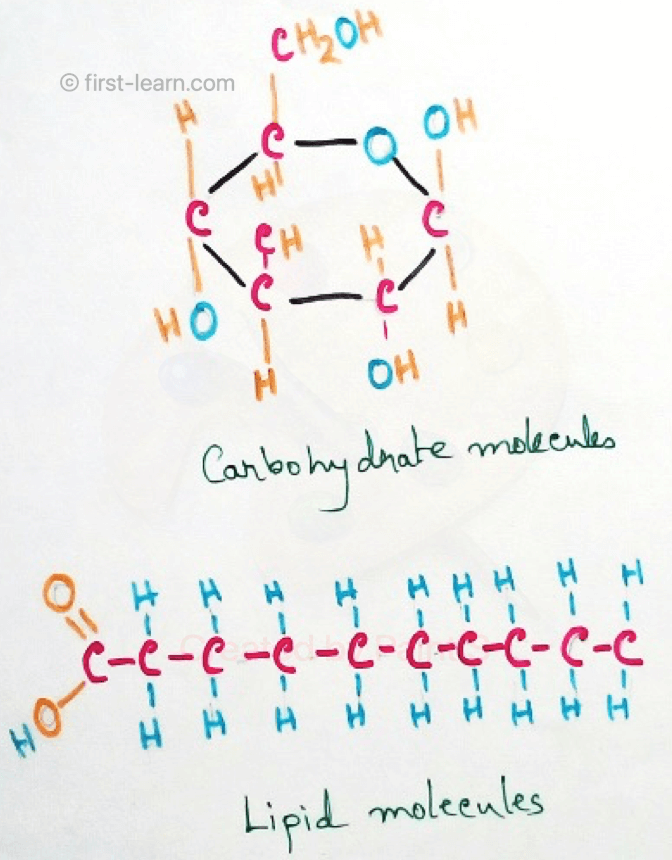Biomolecules
Definition of Biomolecules - All molecules of the living organisms or chemicals of living organisms which are functional within them are known as biomolecules. It is associated with almost 1000 types of chemical reaction in animal cell. Different types of chemicals present in the cells are called cellular pools. Almost about 5000 chemicals can occur in cells. According to their different size biomolecules are of mainly two types.
Macromolecules – Macromolecules are large sized, complex molecules of high molecular weight that are commonly formed due to condensation or polymerisation of repeated units of micromolecules. Examples of micro-molecules are glycogen, starch, inulin, cellulose, called, chitin, pectins etc.
Micromolecules - Micromolecules are small sized, simple molecules with low molecular weight. Example of micromolecules are water, minerals, sugars, lipids, amino acids.
Means the organic molecules which must contains carbon, hydrogen atoms are called biomolecules. Biomolecules can be of different types. They are –
1. Carbohydrate molecules - Carbohydrate molecules are made up of carbon, hydrogen, oxygen and in some cases may be other element or groups are attached. It can be of single chain or branching. Different types of carbohydrates are –
Monosaccharide - These are monomers of sugar that cannot be hydrolyzed into further smaller unit. Example is glucose, fructose etc
Disaccharides - This type of carbohydrates are made up of two same or different monomers of carbohydrates. Examples is glucose and fructose together form sucrose.
Polysaccharides - This molecule of carbohydrates made up of more than two or many different molecules of sugar. Examples of polysaccharides are hexose, heptoses, Pentose etc.
Other polysaccharides - Some other polysaccharides are there which is combined with other element or compound of the cell.
2. Amino acid molecules - Amino acids are the basic units of protein. Different amino acids are combined in different ways to form different protein. They are basically acidic, neutral, alcoholic, sulpher containing, aromatic,. Heterocyclic. Aliphatic amino acids are of four types - monoaminocarboxilic acid, diaminocarboxylic acid, diaminomonocarboxilic acid.
3. Fatty acid molecules - These are made up of carbon, hydrogen, oxygen in the molecules, where ratio oh hydrogen and oxygen are less than water.
Lipids – Esters of fatty acids and alcohol. They are saturated and unsaturated fatty acids.
Waxes - bee wax, lanolin, plant waxes etc.
Phospholipid - Lecithin, cephalin, glycolipids etc.
Sphingolipids - Cerebrosides, gangliosides.
Sterols - Cholesterol
Terpenes - Rubber, camphor, menthol, carotenes, xanthophylls.
Prostaglandins - Different hormones like C20 unsaturated fatty acid formed from arachidonic acid.
4. Different complex biomolecules - This are some types of molecules which combined with either same kind of different molecules or different kinds of molecules. As a result they form complex compound. Examples of complex compound are sphingolipids, sphingomyelin etc.
5. Nucleotides - Penrose sugar, ribose, deoxyribose occurs in nucleotides and nucleic acids.
6. Nucleotisides - Nucleotides are compounds that formed from nitrogen bases and Pentose sugar. Uracil produce nucleoside with only ribose sugar and thiamine forms the same with only deoxyribose sugar.
7. Nitrogen bases - Nitrogen bases are of two types. One is purines and another is pyrimidine. Purine is consists of adenine and guanine. Whereas pyrimidine is consists of thymine, cytosine and in some cases (RNA) uracil.
From Biomolecules to HOME PAGE
Recent Articles
-
What Is Plasma? | Blood Plasma | Proteins | Nutrients | Cholesterol
Nov 07, 25 10:29 AM
Blood is a mobile fluid which is a connective tissue and is derived from the mesoderm like cell any other connective tissue. Colour of blood is reddish and that flows inside the blood vessels by means… -
Disorders of Respiratory System | Tuberculosis | Pleurisy | Emphysema
Oct 28, 25 11:39 PM
Tuberculosis is very common disease and is caused by a type of bacteria called Mycobacterium tuberculosis. This disease causes different trouble in the respiration and infection of several parts of th… -
Regulation of Respiration | Respiratory Centres | Inspiratory Area |
Oct 14, 25 12:13 AM
Respiratory Centre is the area that controls the rate of respiration and it is observed to be located in medulla oblongata and pons. Respiratory Centre has the following will dispersed components like… -
Explain Transport of Gases | External Respiration | Tissue Respiration
Oct 09, 25 11:35 PM
In humans gaseous exchange is completed in the following ways the steps are - External Respiration or Breathing - Breathing in false taking in of Oxygen and giving out of carbon dioxide in the body. M… -
Kind and Number of Teeth | Location of Teeth in Mouth | Care of Teeth
Sep 11, 25 12:52 AM
Kind and Number of Teeth















New! Comments
Have your say about what you just read! Leave me a comment in the box below.